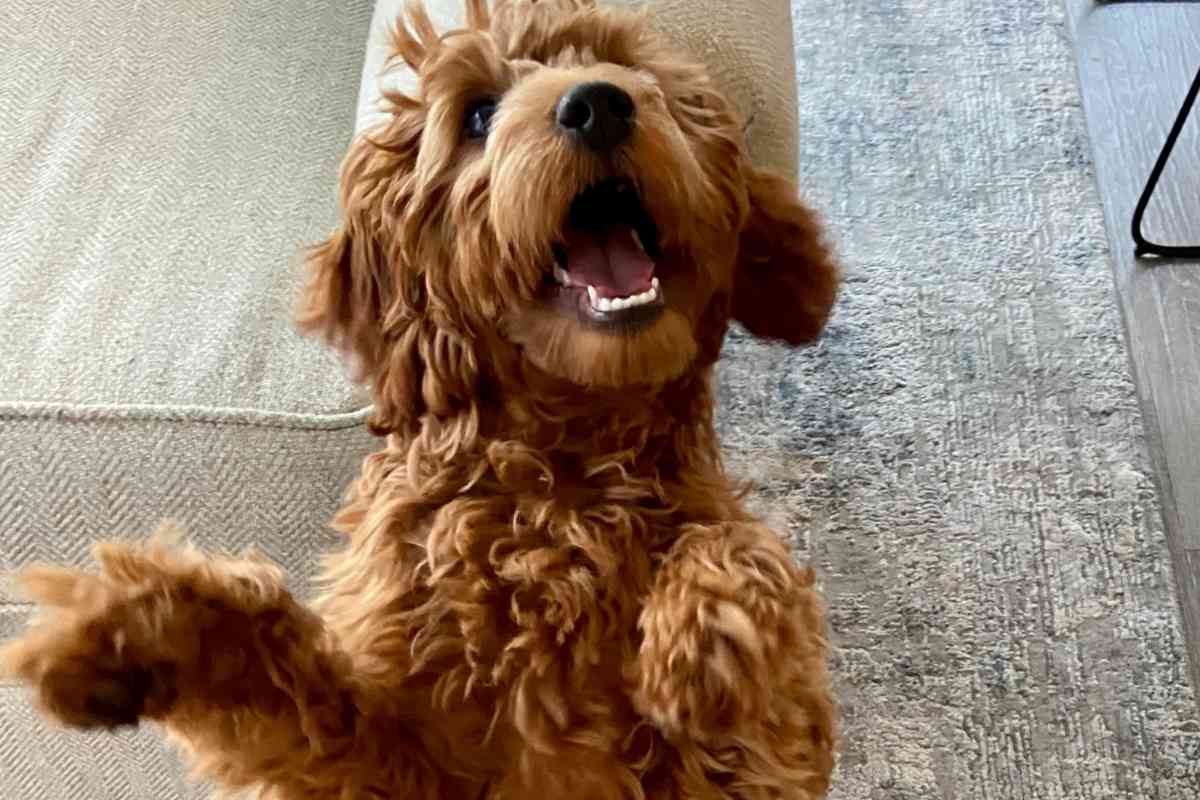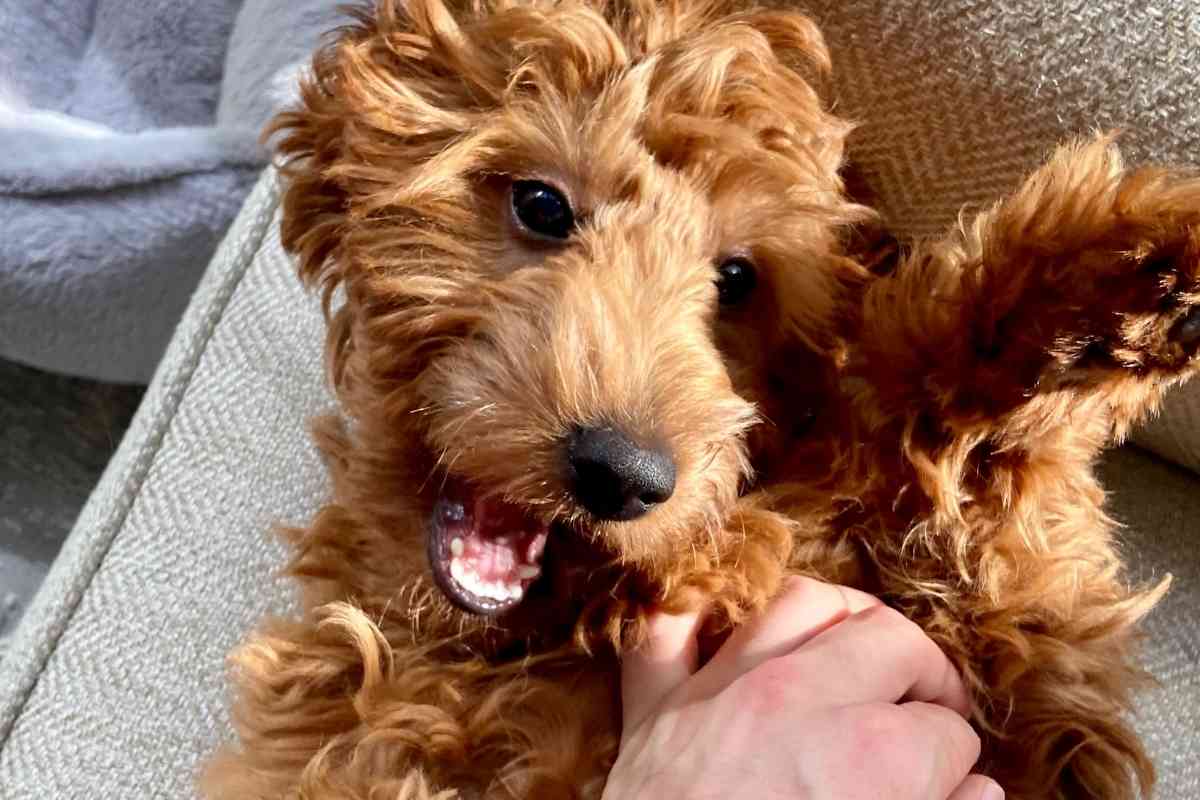Do F1 Goldendoodles Shed?
When you talk about getting a dog, one of the topics that will be considered the most will be shedding, and that can be a very important topic for pet parents a number of reasons, allergies being the highest among them. Getting a low-shedding breed may be very important, so picking there right generation Goldendoodle will be equally imporant.

Do F1 Goldendoodles Shed?
F1 Goldendoodles do shed. These dogs are fifty percent Poodle and fifty percent Golden Retriever, so they will shed less than a normal pure-bred Golden Retriever. However, this breed still sheds more than the Poodle parent and is, therefore, less hypoallergenic overall.
Mixing dog breeds into hybrids like doodles can be a little difficult to understand, especially when it comes to shedding and non-shedding. But Goldendoodles are pretty easy to understand when it comes to the genetics of their parents, and there can be easy ways to take care of any shedding problems.
Goldendoodles Genetics
There are basically two ways that breeders create a Goldendoodle puppy.
One is breeding a purebred Golden Retriever and a Poodle (F1), and the second is a Goldendoodle breeding a Goldendoodle (F2). Either way, the resulting first generations of Goldendoodle puppies will get 50% Golden Retriever genes and 50% Poodle genes.
So, because these dogs have half of the Golden Retriever genetics, they do shed, but not as much. However, with the F2 Goldendoodles, the coat types these Goldendoodles have may differ.
For the first generation of F2 Goldendoodles, they may have two pairs of the Golden Retriever’s shedding genes which will result in more shedding, but not as much as a Golden Retriever. The shorter the coat of a Goldendoodle, the more of the Poodle is expressed, and the less it may shed.
The Goldendoodle that is created by a Golden Retriever and a Poodle is called the F1 Goldendoodle.
F1 = Golden Retriever x Poodle.
The F2 Goldendoodle has both F1 parents, and at this point, these Goldendoodles have half Golden Retriever and half Poodle extending back for generations.
F2 = Goldendoodle x Goldendoodle.
The F1b, however, is the breeding of F1 and a Poodle. Typically. This could also be applied with an F1 and a Golden Retriever if you are the type that doesn’t care if the resulting puppy will shed close to as much as a Golden Retriever.
The resulting puppy from an F1 and Poodle is 75% Poodle, which means that it will definitely have a shorter coat and be a low-shedding dog. If you’re ever wondering “how much do Goldendoodles shed,” you just need to look at the amount of Poodle that they have in them. A purebred Poodle will hardly shed at all, and Poodle mixes benefit from that characteristic from their parent breed.
The F1bb is also the breeding of F1b and a Poodle, and if you can see that pattern that’s occurring, these Goldendoodles will turn out more Poodle with a little Golden Retriever with every generation.
F1bb = F1b Goldendoodle x Poodle.
The “b” in the generations of F1b and F1bb stands for “back-cross.” This means that with every F1 or F2 Goldendoodle, the purebred of the original parent – typically a Poodle or a Golden Retriever – will be bread with the Goldendoodle.
The typical genes of a Poodle range from wavy to curly hair, and Golden Retrievers have fur that is smooth and shed a lot. The personalities can be a mix of intelligence, loyalty, love, playfulness, and energy.
Cleaning Goldendoodle Shedding
Vacuum!!!
The vacuum will forever be your best friend, especially if you have a lot of carpet! And just as a normal tip of cleaning the house, vacuum in all directions so it is picking up all of the dog’s dander, fur, saliva, urine, hair, and any other disgusting pet allergies it can.
With a kitchen and dining room floor, you will often have to mop, and not just once a week. Twice would do it pretty well if you don’t like seeing dog hair on the floor where the babies are crawling. Got to protect the kiddos from a potential allergic reaction!
Do not shove the grime and hair into corners and “promise” yourself to go back to it later. It will get more disgusting, and this author has done it plenty of times to know that it is a bad idea.
When you do laundry, you will have dog hair. Especially if you are a pup-lover. Use dryer sheets when you do laundry because they will pick up more hair and lint off of your clothing than the lint roller that is already installed in the dryer. And also, it makes the clothes so much softer.
If you don’t want dog hair on the couches, or any stains or scratches, get covers for the couches meant for dogs. You can also use throws, quilts, and blankets, and you can just throw those in the wash when they get too messy.
Grooming

One thing to do when grooming your Goldendoodle is to brush his hair weekly. It may also depend on the length of the hair if it’s straight like a Golden Retriever’s or curly like a Poodle’s. But you must
Let it be reminded that Doodles do shed. They will always shed, no matter how much Poodle is in them. The amount of shedding will always vary, but not a single Goldendoodle will shed as much as a Golden Retriever.
Brushing may seem rather simple, but if you neglect to do so, the hair will get tangled and matted together, and once you do start brushing, your Goldendoodles will be very upset at you for pulling at his hair, and the last thing you want to do is shave it. It doesn’t grow back very well.
Goldendoodles shed seasonally, so be prepared when summer comes along and it starts to get hot because of their double coat. Winter will not be as bad because these dogs have so much hair that it protects them from the cold.
Let it be reminded that Doodles do shed. They will always shed, no matter how much Poodle is in them or what their. The shedding will always vary, but not a single Goldendoodle will shed as much as a Golden Retriever.
Remember that your Goldendoodle puppy will lose their puppy coat and grow in their adult coat. Often, the wavy coat of their puppyhood is replaced with a course, curlier coat.
A well-balanced diet full of proper nutrients and omega-fatty acids can help with shedding problems too.
When bathing Goldendoodles, the frequency of doing so should be once a month and no more. The more often you bathe the Goldendoodle, it can lead to dry skin, which could then further cause itching in your dogs.
On the not-so-frequent occasions you do bathe them, make sure you clean them exceptionally, checking behind their ears, the eyes for goop, and any other spots that could easily go unnoticed on a daily basis.